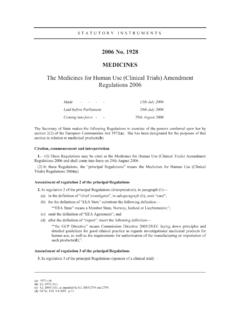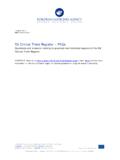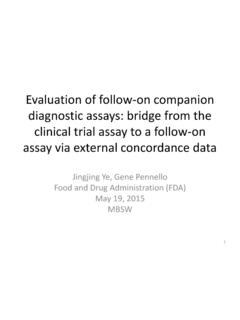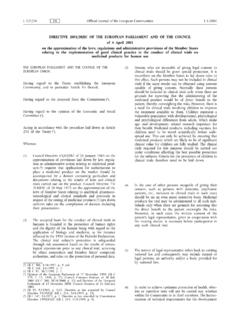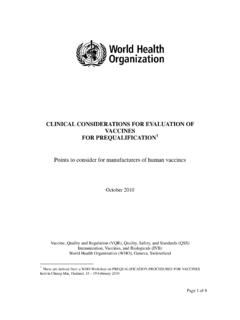Transcription of Annex 1 Guidelines on clinical evaluation of vaccines ...
1 35 GAnnex 1 Guidelines on clinical evaluation of vaccines : regulatory expectationsThis document provides guidance for national regulatoryauthorities and vaccine manufacturers on the clinical evalu-ation of vaccines by outlining the international regulatoryexpectations applicable to the different stages of vaccinedevelopment and for marketing approval. For this reason,the guidance in this document could also be useful for clini-cal researchers and text is presented in the form of Guidelines rather thanrecommendations because vaccines are a heterogeneousclass of agents, and the preclinical and clinical testingprogrammes will need to be adapted for each individualproduct.
2 Guidelines allow greater flexibility than recom-mendations with respect to specific issues related to particu-lar separate WHO document intended to provide more de-tailed guidance on preclinical and laboratory evaluationof vaccines is in preparation. This was subsequentlyestablished by the 54th meeting, November 2003, of theWHO Expert Committee or Biological Standardization andis to be published in the WHO Technical Report Series. Thesection of this document that discusses preclinical andlaboratory evaluation consequently provides general guidance,but does not define international regulatory expectations inthis area.
3 World Health OrganizationWHO Technical Report, Series No. 924, 2004 ECB text19/11/2004, 09:48 AM35 Black36 GIntroduction36 Regulation of vaccines37 Glossary40 Scope of the document48 Part A. Preclinical and laboratory evaluation of General Production, characterization and quality assurance of Toxicity and safety Potency and Special considerations53 Part B. clinical evaluation of General Methodological Statistical Ethical Phase I Phase II Phase III Bridging Post-licensure studies and Special considerations for combination vaccines90 Authors93 Acknowledgements94 Appendix95 Summary protocol for vaccine evaluations95 References96 IntroductionThis document provides guidance to national regulatory authorities(NRAs)
4 , manufacturers, clinical researchers and investigators on theclinical evaluation of vaccines by outlining the data that should beobtained during the different stages of vaccine development to sup-port an application for marketing approval. This document has beenprepared in response to requests from NRAs for assistance in theevaluation of clinical trials, both during the clinical development of anew vaccine and during the regulatory review of dossiers submitted insupport of applications for marketing authorization.
5 The NRAsECB text19/11/2004, 09:48 AM36 Black37 Gshould have a mandate to review protocols, and when this is necessaryto protect the safety of subjects, to require revision of the protocoland/or termination of the trial. This document is intended to providebasic guidance to NRAs on how to achieve these objectives. Becauseit is common practice for the clinical development programmes andthe individual clinical trials to take place in different countries, eachNRA should, as far as possible, collaborate with the other regulatoryauthorities involved to benefit from shared experiences and to alignregulatory considerations (1).
6 The World Health Organization (WHO) has made available the fol-lowing Guidelines and requirements that are relevant to the evalua-tion of vaccines : good clinical practice for trials on pharmaceuticalproducts (2), good manufacturing practice for pharmaceutical prepa-rations (3, 4), good manufacturing practice for biological products (5),regulation and licensing of biological products in countries with newlydeveloping regulatory authorities (1) and Guidelines for national au-thorities on quality assurance for biological products (6).
7 Guidelinesand recommendations for the production and control of specificvaccines have been reviewed in detail in a series of WHO technicalreports (7), which should be consulted where applicable but will notbe discussed further here. However, there is no existing WHO docu-ment that gives guidance on the planning, performance and assess-ment of clinical studies on vaccines with a regulatory WHO Guidelines that complement this document are avail-able for malaria (8) and dengue (9) or are in preparation in the caseof certain candidate vaccines , such as for human immunodeficiencyvirus (HIV).
8 Basic standards of care, including details about the coldchain required for transport and storage of vaccines , proper injectiontechniques for delivery of vaccines and safety of injections have al-ready been described in the WHO manual Immunization in practice(10).Guidance on various aspects of clinical trials of vaccines is also avail-able from several other bodies such as the International Conferenceon Harmonization (ICH), the European Agency for the evaluation ofMedicinal Products (EMEA), the United States Food and Drug Ad-ministration (FDA) and the United Kingdom Medical ResearchCouncil (MRC).
9 These WHO Guidelines are not intended to conflictwith, but rather to complement, these other documents (11 16, 18 39).ECB text19/11/2004, 09:48 AM37 Black38 GRegulation of vaccinesRegulatory issues related to a particular candidate vaccine should beconsidered early in the development process, since compliance withregulatory requirements is the basis for eventual approval. It isstrongly recommended that dialogue with the appropriate nationalregulatory authority be established early on. The national regulatoryauthority should review the plans for development of the candidatevaccine and clarify requirements for carrying out clinical trials, as wellas for marketing regulation of vaccines can be divided into three stages: develop-mental, licensure and postlicensure (40).
10 The developmental stageconsists of two parts, preclinical research and development, and clini-cal research and testingPreclinical research and development are carried out in the labora-tory using in vitro techniques or, when necessary, in vivo techniquesin animals. The data from preclinical and laboratory research includedetails of the development and production of a vaccine together withreports of control testing, which should be adequate to justify subse-quent clinical studies in of clinical development (I III) clinical trials in humans are classified into three phases: phase I,phase II and phase III and in certain countries formal regulatoryapproval is required to undertake any of these studies.











